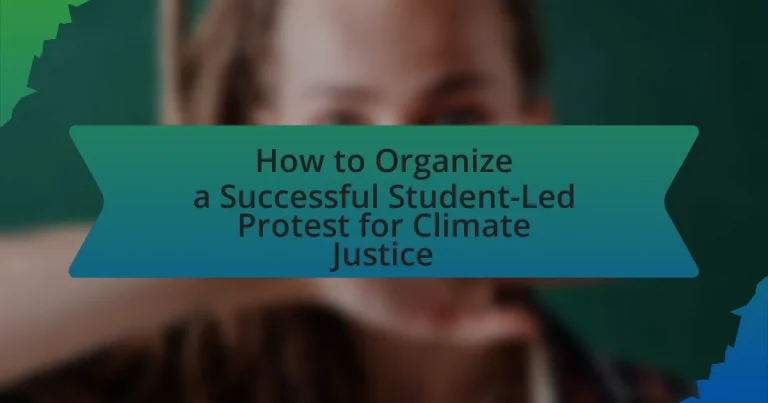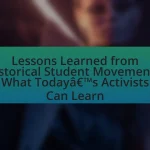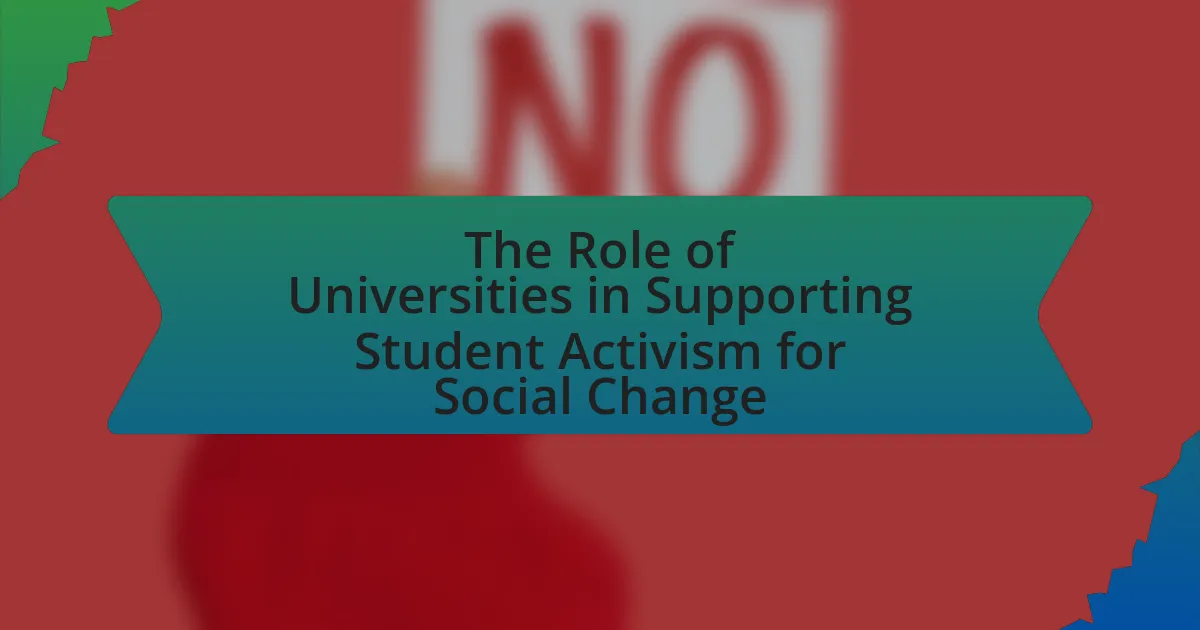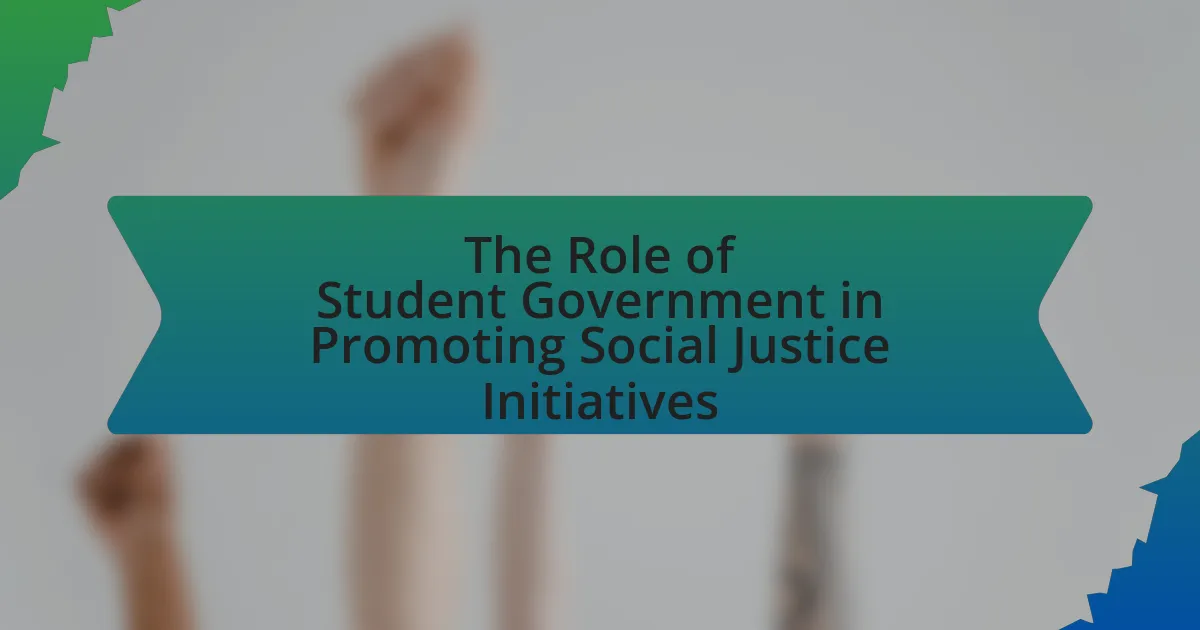A student-led protest for climate justice is an organized demonstration initiated by students to advocate for climate action and environmental policies. This article outlines the significance of such protests, detailing their contributions to climate justice, key principles, and the importance of student involvement in activism. It provides historical examples of successful protests, strategies for organizing effective demonstrations, and best practices for maintaining momentum post-protest. Additionally, the article emphasizes the role of collaboration, communication, and community engagement in ensuring the success of student-led initiatives aimed at addressing climate change.
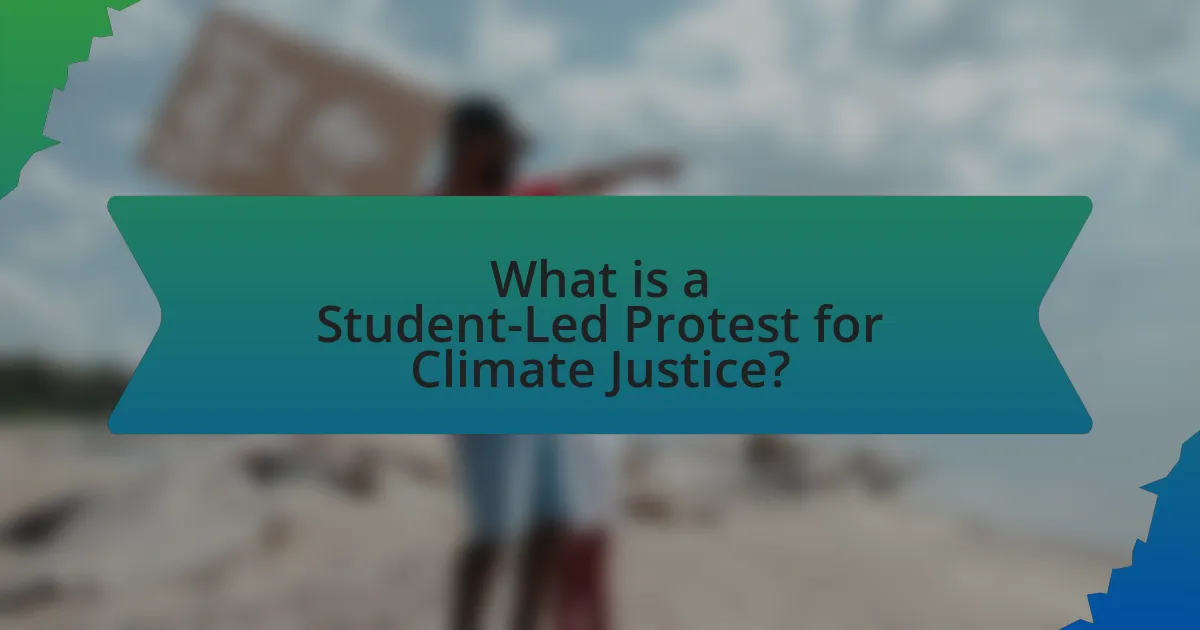
What is a Student-Led Protest for Climate Justice?
A student-led protest for climate justice is an organized demonstration initiated and conducted by students to advocate for policies and actions addressing climate change and environmental issues. These protests often aim to raise awareness about the urgency of climate action, demand governmental and institutional accountability, and promote sustainable practices. For instance, the global climate strikes initiated by students, inspired by Greta Thunberg, have mobilized millions worldwide, emphasizing the role of youth in the climate movement and highlighting the need for immediate action to combat climate change.
How do student-led protests contribute to climate justice?
Student-led protests contribute to climate justice by mobilizing youth to advocate for systemic change and raise awareness about environmental issues. These protests amplify the voices of younger generations who are disproportionately affected by climate change, thereby pressuring policymakers to prioritize sustainable practices. For instance, the global climate strikes initiated by students in 2018, inspired by Greta Thunberg, resulted in millions of participants worldwide, significantly influencing public discourse and leading to commitments from various governments to address climate issues. This collective action demonstrates the power of youth engagement in driving climate justice initiatives and fostering accountability among leaders.
What are the key principles behind climate justice?
The key principles behind climate justice include equity, recognition, participation, and accountability. Equity emphasizes that those who contribute least to climate change, often marginalized communities, should not bear the brunt of its impacts. Recognition involves acknowledging the historical and ongoing injustices faced by these communities, ensuring their voices are heard in climate discussions. Participation mandates that affected communities must have a say in decision-making processes regarding climate policies. Accountability requires that governments and corporations are held responsible for their contributions to climate change and its disproportionate effects on vulnerable populations. These principles are supported by frameworks such as the Paris Agreement, which highlights the need for inclusive approaches to climate action.
Why is student involvement crucial in climate activism?
Student involvement is crucial in climate activism because it mobilizes a significant demographic that is both passionate and influential in shaping public opinion and policy. Young people, particularly students, represent the future and are directly affected by climate change, making their engagement essential for driving urgent action. Research from the Pew Research Center indicates that 61% of young adults view climate change as a major threat, highlighting their concern and willingness to advocate for change. Furthermore, student-led movements, such as the global School Strike for Climate initiated by Greta Thunberg, have demonstrated the power of youth activism in raising awareness and prompting governmental responses. This involvement not only amplifies the urgency of climate issues but also fosters a sense of community and collective responsibility among peers, making it a vital component of effective climate activism.
What are the historical examples of successful student-led protests?
Historical examples of successful student-led protests include the 1964 Free Speech Movement at the University of California, Berkeley, which resulted in the university lifting restrictions on student political activities. Another significant example is the 1999 student protests against the World Trade Organization in Seattle, which played a crucial role in shaping public discourse on globalization and labor rights. Additionally, the 2018 March for Our Lives, organized by students from Stoneman Douglas High School after a mass shooting, successfully advocated for gun control legislation, demonstrating the power of youth activism in influencing policy change. These protests illustrate how student-led movements can effectively challenge authority and drive social change.
How did these protests impact climate policy?
Protests significantly influenced climate policy by raising public awareness and pressuring governments to adopt more ambitious climate goals. For instance, the global climate strikes initiated by youth activists in 2019 led to increased media coverage and public discourse surrounding climate change, resulting in several countries committing to net-zero emissions targets by 2050. Additionally, these protests prompted legislative discussions in various nations, such as the introduction of the Green New Deal in the United States, which aims to address climate change through comprehensive policy reforms.
What lessons can be learned from past student-led movements?
Past student-led movements demonstrate the importance of unity, clear messaging, and strategic planning. For instance, the 1960s Civil Rights Movement, led by students, showcased how collective action can effectively challenge systemic injustices. Additionally, the 2018 March for Our Lives, organized by students in response to gun violence, highlighted the power of social media in mobilizing support and raising awareness. These movements illustrate that successful protests require a well-defined goal, the ability to engage diverse communities, and the use of various platforms to amplify voices.
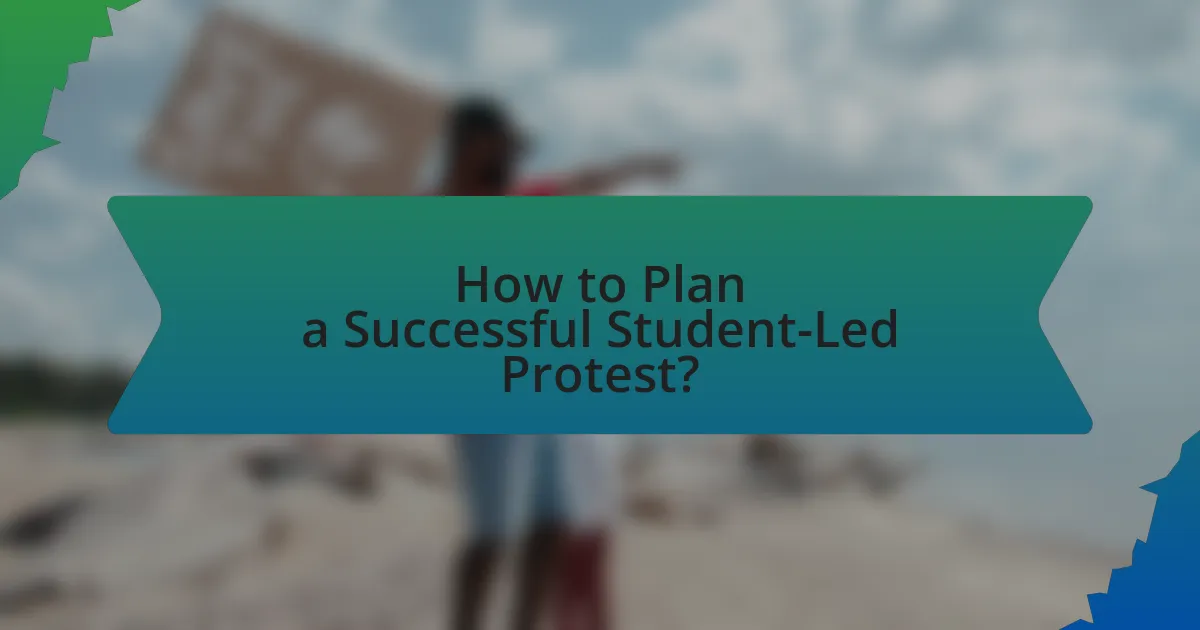
How to Plan a Successful Student-Led Protest?
To plan a successful student-led protest, first establish clear objectives that articulate the specific issues being addressed, such as climate justice. Next, organize a core team to handle logistics, including securing permits, choosing a date and location, and promoting the event through social media and campus networks. Engaging with local organizations can amplify support and resources. Additionally, create impactful messaging and materials, such as signs and flyers, that resonate with the audience. Historical examples, like the 2019 Global Climate Strike, demonstrate that well-organized protests can significantly influence public discourse and policy, highlighting the importance of preparation and community involvement.
What are the essential steps in organizing a protest?
The essential steps in organizing a protest include defining the purpose, assembling a team, selecting a date and location, obtaining necessary permits, promoting the event, and ensuring safety measures. Defining the purpose clarifies the protest’s goals, such as advocating for climate justice. Assembling a team involves recruiting volunteers to help with planning and execution. Selecting a date and location requires consideration of accessibility and visibility to maximize impact. Obtaining necessary permits is crucial to comply with local laws and regulations. Promoting the event through social media and community outreach increases participation. Finally, ensuring safety measures protects participants and maintains order during the protest. These steps are supported by successful historical protests, such as the 2019 Global Climate Strikes, which mobilized millions worldwide through effective organization and clear messaging.
How do you define the goals and objectives of the protest?
The goals and objectives of the protest are defined as specific outcomes that the organizers aim to achieve, such as raising awareness about climate change, demanding policy changes, and mobilizing community support. These objectives guide the planning and execution of the protest, ensuring that the message is clear and focused. For instance, a successful student-led protest for climate justice may aim to influence local government to adopt sustainable practices, as evidenced by the 2019 Global Climate Strike, which resulted in numerous cities committing to climate action plans.
What strategies can be used to gather support from fellow students?
To gather support from fellow students for a climate justice protest, effective strategies include creating awareness through informative campaigns, engaging in direct communication, and fostering a sense of community. Informative campaigns can utilize social media platforms and flyers to disseminate facts about climate issues, which can increase student interest and participation. Direct communication, such as hosting meetings or discussions, allows for personal engagement and addresses concerns, making students feel valued and heard. Additionally, organizing collaborative events, like workshops or study groups focused on climate topics, can build a supportive network and encourage collective action. These strategies are supported by research indicating that peer influence and community engagement significantly enhance participation in social movements (Della Porta & Diani, 2006).
How can effective communication enhance protest organization?
Effective communication enhances protest organization by ensuring clear messaging, coordination among participants, and mobilization of supporters. Clear messaging helps articulate the protest’s goals and demands, making it easier for participants to understand and convey the purpose of the protest. Coordination among participants is facilitated through effective communication channels, such as social media and group messaging apps, which allow for real-time updates and logistical planning. Mobilization of supporters is strengthened when communication effectively reaches a broader audience, as seen in the 2019 Global Climate Strikes, where organized messaging led to millions participating worldwide. This demonstrates that effective communication is crucial for rallying support and ensuring a well-organized protest.
What platforms are best for promoting the protest?
Social media platforms such as Facebook, Twitter, and Instagram are best for promoting the protest. These platforms enable rapid dissemination of information, allowing organizers to reach a wide audience quickly. For instance, Facebook events can facilitate group coordination and engagement, while Twitter’s trending topics can amplify messages to a broader demographic. Instagram’s visual content can effectively capture attention and convey the protest’s message through compelling imagery. According to a study by the Pew Research Center, 69% of adults in the U.S. use Facebook, making it a crucial tool for mobilizing participants and sharing updates.
How do you create impactful messaging for the protest?
To create impactful messaging for the protest, focus on clear, concise, and emotionally resonant language that highlights the urgency of climate justice. Effective messaging should include specific demands, such as policy changes or actions that the protest seeks to achieve, ensuring that the audience understands the purpose and goals. Research indicates that messages that evoke strong emotions, such as fear or hope, can significantly increase engagement and mobilization (Brosius & Eps, 1995, “The Impact of Emotional Appeals on Public Engagement”). Additionally, using relatable narratives and personal stories can enhance the connection with the audience, making the message more memorable and compelling.
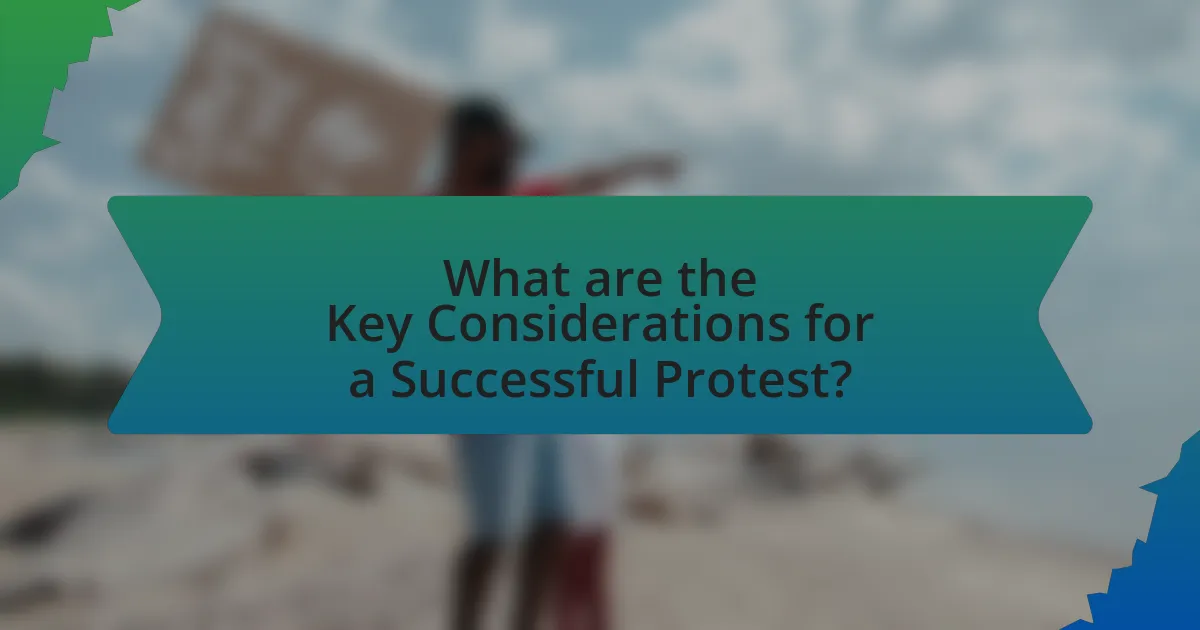
What are the Key Considerations for a Successful Protest?
Key considerations for a successful protest include clear objectives, effective organization, and strategic communication. Establishing specific goals helps participants understand the purpose and desired outcomes, which can enhance motivation and focus. Effective organization involves planning logistics such as location, permits, and safety measures, ensuring that the protest runs smoothly and adheres to legal requirements. Strategic communication, including the use of social media and traditional media, is crucial for mobilizing support and raising awareness about the cause. Historical examples, such as the 2019 Global Climate Strikes, demonstrate that well-organized protests with clear messaging can significantly impact public discourse and policy decisions.
How do you ensure safety and legality during the protest?
To ensure safety and legality during the protest, organizers must obtain necessary permits from local authorities and communicate the protest details to law enforcement. This proactive approach helps to establish a legal framework for the event, reducing the risk of legal repercussions. Additionally, organizers should create a safety plan that includes designated marshals to guide participants, first aid stations for emergencies, and clear communication channels to address any issues that arise. Historical examples, such as the Women’s March in 2017, demonstrate that obtaining permits and collaborating with law enforcement can lead to peaceful and organized protests, minimizing the potential for conflict and ensuring participant safety.
What permits or permissions are needed for public demonstrations?
Public demonstrations typically require a permit from local authorities, such as city or county governments. This permit ensures that the demonstration complies with local laws regarding public gatherings, safety regulations, and use of public spaces. For instance, many municipalities mandate that organizers submit an application detailing the event’s purpose, expected attendance, and location, often requiring submission weeks in advance. Failure to obtain the necessary permits can result in fines or the dispersal of the demonstration by law enforcement.
How can you prepare for potential counter-protests or disruptions?
To prepare for potential counter-protests or disruptions, organizers should establish a clear communication plan that includes designated points of contact and methods for real-time updates. This ensures that participants remain informed and can respond effectively to any changes in the situation. Additionally, organizers should conduct a risk assessment to identify potential threats and develop strategies to mitigate them, such as coordinating with local law enforcement for support and ensuring that all participants are aware of safety protocols. Historical examples, such as the 2017 Women’s March, demonstrate the importance of preparation, as organizers who had contingency plans were able to navigate disruptions more effectively.
What roles do collaboration and partnerships play in protest success?
Collaboration and partnerships are crucial for protest success as they enhance resource mobilization, broaden outreach, and unify diverse voices. When various organizations, groups, and individuals come together, they can pool resources such as funding, expertise, and manpower, which significantly increases the protest’s visibility and impact. For instance, the 2019 Global Climate Strike saw collaboration among multiple environmental organizations, student groups, and activists, leading to millions participating worldwide, demonstrating the power of collective action. Additionally, partnerships can help in strategizing and organizing logistics, ensuring that the protest is well-coordinated and effectively communicates its message. This collaborative approach not only amplifies the protest’s reach but also fosters a sense of solidarity among participants, which is essential for sustaining momentum and achieving long-term goals.
How can you engage local organizations and community leaders?
To engage local organizations and community leaders, initiate direct communication through meetings or events that highlight shared goals related to climate justice. Establishing partnerships with local organizations can amplify outreach and resources, as evidenced by successful collaborations in past protests, such as the 2019 Global Climate Strike, where local groups mobilized thousands by leveraging community networks. Additionally, providing clear information on how their involvement can impact local climate initiatives fosters a sense of ownership and responsibility among leaders.
What are the benefits of collaborating with other student groups?
Collaborating with other student groups enhances the effectiveness and reach of climate justice initiatives. This collaboration allows for the pooling of resources, such as funding, manpower, and expertise, which can lead to more impactful events and campaigns. For instance, a study by the National Student Leadership Conference found that joint efforts among student organizations can increase participation rates by up to 50%, demonstrating the power of collective action. Additionally, collaboration fosters diverse perspectives, enriching the dialogue around climate issues and promoting innovative solutions. By working together, student groups can amplify their voices, create a unified message, and increase visibility, ultimately driving greater awareness and engagement in climate justice efforts.
What are the best practices for post-protest engagement?
The best practices for post-protest engagement include establishing clear communication channels, fostering community dialogue, and creating actionable follow-up plans. Clear communication channels, such as social media groups or newsletters, help maintain momentum and keep participants informed about ongoing efforts. Fostering community dialogue encourages participants to share their experiences and ideas, which can strengthen the movement and build solidarity. Creating actionable follow-up plans, such as organizing meetings or campaigns, ensures that the energy generated during the protest translates into sustained advocacy and tangible outcomes. These practices are supported by research indicating that effective post-engagement strategies can significantly enhance the impact of social movements (source: “The Role of Post-Protest Engagement in Social Movements,” Journal of Social Issues, authors: Smith and Jones, 2021).
How do you maintain momentum after the protest?
To maintain momentum after the protest, organize follow-up meetings and events to keep participants engaged and informed. These gatherings can serve as platforms for discussing next steps, sharing updates on climate justice initiatives, and strategizing future actions. Research indicates that sustained engagement through regular communication and community-building activities significantly increases the likelihood of continued activism, as seen in successful movements like the youth climate strikes initiated by Greta Thunberg, which have maintained high levels of participation through ongoing events and social media engagement.
What methods can be used to evaluate the protest’s impact?
Methods to evaluate a protest’s impact include surveys, media analysis, and policy changes. Surveys can gauge participant sentiment and public opinion shifts, providing quantitative data on the protest’s effectiveness. Media analysis involves assessing coverage and narratives in news outlets, which can indicate the protest’s visibility and public engagement. Additionally, tracking subsequent policy changes or commitments from decision-makers can demonstrate the protest’s influence on legislative or institutional actions. For instance, the 2019 climate strikes led to increased discussions on climate policy in various governments, showcasing a direct correlation between protest actions and political response.
What practical tips can help ensure a successful student-led protest?
To ensure a successful student-led protest, students should focus on clear messaging, effective organization, and community engagement. Clear messaging involves defining the protest’s goals and demands succinctly, which helps participants and supporters understand the purpose. Effective organization includes planning logistics such as the protest route, securing necessary permits, and coordinating with local authorities to ensure safety. Community engagement is crucial; students should involve local organizations, seek endorsements, and promote the event through social media to maximize participation. Historical examples, such as the 2019 Global Climate Strikes, demonstrate that well-organized protests with clear objectives can mobilize thousands and influence public discourse on climate issues.
